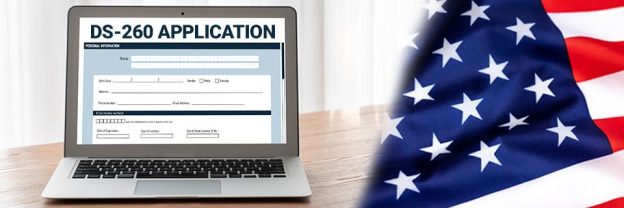
Every foreign individual looking to permanently relocate to and live in the United States is required to submit an application for an immigrant visa to the United States Citizenship and Immigration Services (USCIS). This application is digitally filed using Form DS-260, Immigrant Visa Electronic Application.
This article provides detailed insights into the DS-260, highlighting its importance for the EB-5 Immigrant Investor Program.
The EB-5 Immigrant Investor Program
- Eligibility Criteria for EB-5 Investors
- Investment Options within the EB-5 Program
- Criteria for Submitting Forms I-526 and I-526E
- Transitioning to a Permanent EB-5 Green Card
Understanding the Role of DS-260
Timeline for the EB-5 Visa Application Process
Start Your EB-5 Journey with EB5AN
The EB-5 Immigrant Investor Program

The EB-5 program was initiated by Congress in 1990 with the aim of boosting the U.S. economy through foreign investments into American businesses, known as new commercial enterprises (NCEs), while also generating employment opportunities for American workers. In return, foreign investors, along with their immediate family members (spouses and unmarried children under the age of 21) gain eligibility for conditional Green Cards. These Green Cards permit them to live and work in the United States. This particular status is effective for two years and can transition into permanent Green Cards, if the investor fulfills all the requirements of the program.
Eligibility Criteria for EB-5 Investors
For foreign nationals aiming to gain permanent residency in the United States, the EB-5 program offers the most direct path. To qualify, an investor must invest a specified minimum amount into a new commercial enterprise (NCE) that generates employment for American workers. This minimum investment is $800,000 for projects located in a targeted employment area (TEA) or $1,050,000 for those outside of a TEA.
A TEA is defined either as a rural area with fewer than 20,000 residents or an urban area where unemployment rates are at least 150% above the national average.
The investment must lead to the creation of at least ten full-time positions for U.S. employees.
Investment Options within the EB-5 Program
EB5 investors have the option to select from two different investment models: investing directly in a new commercial enterprise (NCE) or pooling their resources with other EB5 investors in a project sponsored by a regional center. Regional centers are economic units designated by USCIS, tasked with overseeing EB5 investments in various projects within the industry and ensuring compliance with USCIS standards.
The direct investment model appeals to investors desiring an active role in the NCE’s daily operations and key decision-making processes. This model is mostly suited for businesses in the retail, wholesale trade, services, manufacturing, technology, and agriculture sectors.
On the other hand, EB-5 regional center projects typically involve real estate developments. This model has been the favored choice among EB5 investors.
To initiate the process toward permanent residency, a foreign investor must first select an eligible EB5 project and invest the necessary capital. Then, they can proceed to submit Form I-526E, Immigrant Petition by Regional Center Investor (or Form I-526 for those opting for the direct investment approach), to USCIS.
Criteria for Submitting Forms I-526 and I-526E
When submitting Form I-526E or I-526, investors are required to prove the following points:
- They have committed the necessary minimum investment in an EB-5 project that adheres to USCIS guidelines, either through direct investment or via a designated regional center.
- If their investment is the minimum $800,000, it is in a project situated within a Targeted Employment Area (TEA).
- The investment will lead to the creation of the requisite number of jobs.
- The funds for the investment have been acquired through legal means. Acceptable sources of funds include earnings, dividends, gifts from relatives or acquaintances, inheritances, revenue from selling property, and the sale of shares.
Upon approval of the I-526E petition, USCIS forwards it to the National Visa Center (NVC), which then assigns a case number and requests payment of fees from the EB-5 investor. After that, the NVC asks the investor and each dependent to complete the DS-260 application form and provide the necessary documents. More information about DS-260 filing is available below.
After approval, the investor and their family members are granted conditional permanent residency, allowing them to enter the United States.
Transitioning to a Permanent EB-5 Green Card
The conditional Green Card remains valid for two years. To remove the conditions on their Green Cards and secure unconditional permanent resident status, the EB5 investor along with their family members are required to submit Form I-829, Petition by Investor to Remove Conditions on Permanent Resident Status, within the 90-day period before the card’s expiration. This marks the end of the EB-5 immigration process.
When submitting Form I-829, the immigrant investor needs to prove the fulfillment of all EB-5 program requirements, which include:
- Verifying the existence of the new commercial enterprise (NCE) throughout the investor’s two-year conditional residency.
- Demonstrating that the required minimum investment amount was made.
- Confirming the creation of ten full-time jobs.
The petitioner’s conditional residency status is extended during the processing of the I-829 form. Following approval, the investor and their family members are granted unconditional permanent residency in the United States.
Understanding the Role of DS-260

The DS-260 form serves as the immigrant visa application for foreign nationals planning to permanently relocate to the United States, including EB-5 investors residing overseas. (The DS-230 form was previously utilized for this purpose.) Approval of this application grants the applicant an EB5 visa, enabling them to live in the United States. Immigrants already in the U.S. are required to submit Form I-485, which seeks to adjust their current status to permanent residency.
DS-260 Form Requirements
The DS-260 form requires each applicant to provide the following details:
-
- Their National Visa Center (NVC) case number.
- Their invoice identification number.
- Personal information.
- Adequate travel documentation to confirm identity and nationality.
- Current residence.
- Social media profiles.
- Information on family, including details about parents, spouse(s), and children.
- History of travel to the U.S.
- Employment, education, and training background.
- Security and background details, including:
- Medical and health information.
- Criminal record.
- Violations of immigration law.
All applications must be completed in English.
Processing and Consular Interview
Processing times can vary based on the complexity of the application. For instance, applicants who have traveled extensively to countries considered to be security risks, or those currently living in countries deemed high-risk, might undergo more thorough examination.
After processing the application, an immigration officer will send an interview appointment package to the applicant, scheduling a visa interview at a U.S. embassy or consulate. During the interview, a consular officer will assess the applicant’s eligibility for an immigrant visa. Digital fingerprint scans will also be taken at this time.
Timeline for the EB-5 Visa Application Process

This timeline outlines the necessary steps for an EB5 investor:
-
-
- Choose an EB-5 project that meets eligibility criteria.
- Invest a minimum of $800,000 in the project if it’s situated in a Targeted Employment Area (TEA) or $1,050,000 if located outside of a TEA.
- For direct investments, file Form I-526 with USCIS, or for regional center investments, submit Form I-526E.
- Upon approval, the investor and each family member (residing outside the U.S.) must fill out and submit Form DS-260.
- If residing abroad, an immigration officer will schedule an interview for the applicant(s) at a designated time and date.
- Following the interview and DS-260 approval, the investor is granted an EB5 immigrant visa (conditional Green Card), authorizing residency and employment in the U.S. This visa is valid for two years.
- Before the EB5 visa expires, the investor must submit Form I-829 to remove the conditions on their Green Card.
- With the conditions lifted, the investor obtains permanent residency in the U.S. and becomes a permanent Green Card holder.
-
Start Your EB-5 Journey with EB5AN

The EB5 program is a popular way for foreigners and their families to get permanent residency in the U.S., and filing DS-260 is an important part of it. Just like with any stage in a foreign investor’s immigration journey, it’s recommended that investors seek professional assistance during the immigrant visa application process.
EB5AN has helped more than 2,300 families from 60 countries relocate to the United States as lawful permanent residents. Our expert team has more than a decade of experience, and offers clients first-rate, low-risk EB-5 regional center projects with 100% USCIS project approval rate to date.
For further details about the DS-260, book a one-on-one call with our EB-5 team today and receive professional support through each step of your EB-5 process.











